As professional carpenters or hobbyists, we enjoy spending time in our woodshops. We prefer to spend more hours creating than cleaning, but unfortunately, cleaning consumes a huge chunk of our time.
Aside from the time spent cleaning, wood dust isn't good for your health. Let's talk about ways to keep you healthy in the woodshop and safe during cleanup time.
Table Saw Dust Collection Ideas
We've gathered some ideas to collect the sawdust from your table saw. Read on to find the solution for your woodshop.
Topic Type | Best For |
Install a Dust Port | Portable and Contractor Table Saws |
Add a Box Under Your Table Saw | Hobbyists |
Close the Back of the Saw | Portable and Contractor Table Saws |
Seal the Gaps | Any Table Saw |
Attach a Shop Vac | An Overarm Dust Collector |
Buy or Build an Overarm Dust Collector | Any Table Saw |
Buy a Premade Dust Collection System | Professionals |
Direct the Air, Don’t Restrict It | Professionals and Hobbyists |
Install a Dust Port
Installing a dust port below the saw's blade is a logical first step to collect most of the dust. Use a plastic tray with a built-in 4" port that you'll find at your nearest hardware store. It's easy to cut the plastic tray to size if it's too big or add plywood on the sides if it's too small.

Photo credit: DanPattison.com
Covering small openings with duct tape will keep everything in place and ensure that all the dust is collected. You'll install this on the bottom of a contractor saw, or on the side or back of a cabinet-style saw.
Advantages
- The dust from the blade is mostly below the table, so you'll be able to collect all of that.
- Connected to a dust collector, this will eliminate most of the dust on the shop floor.
- It's an inexpensive and simple solution to collect most of the dust from the saw.
Disadvantages
- If it's not properly sealed off, you'll still have sawdust slipping past your tray.
- A dust port doesn't eliminate all the sawdust beneath the table.
- You'll need to implement additional measurements to catch all of the sawdust.
Best For
Although this installation can work with a cabinet-style saw, it works best with a contractor's table saw. Since the blade cuts down, the sawdust goes in the same direction. It's easier to collect all of it at the bottom of the table frame.
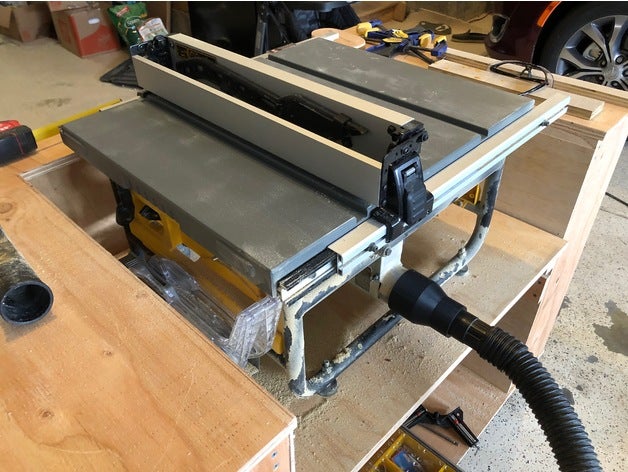
Photo credit: Thingiverse.com
You may choose to connect the dust port to a dust collector; this will make the installation more efficient on a cabinet-style saw. However, if you don't have a dust collector, a dust port will also be efficient with a box or tray beneath your contractor's table saw.
Add a Box Under Your Table Saw
This is a simple solution to a regular problem. The saw blade spins downward, so, naturally, the blade throws the sawdust down towards the floor. Why don't you place a box beneath the table saw to collect the sawdust? The way to do that may depend on a few factors.
The box should be small enough to fit between the legs of the table and high enough, so nothing flies over the sides. At the same time, it should be strong enough to handle the weight of the sawdust. The best material for this box will either be wood, steel, or hard plastic.
Advantages
- You'll be able to collect all the sawdust that goes directly downward from the blade.
- It's an inexpensive solution to collect most of the sawdust.
- No installation time is required. Simply measure the space beneath the table and find a box that will fit.
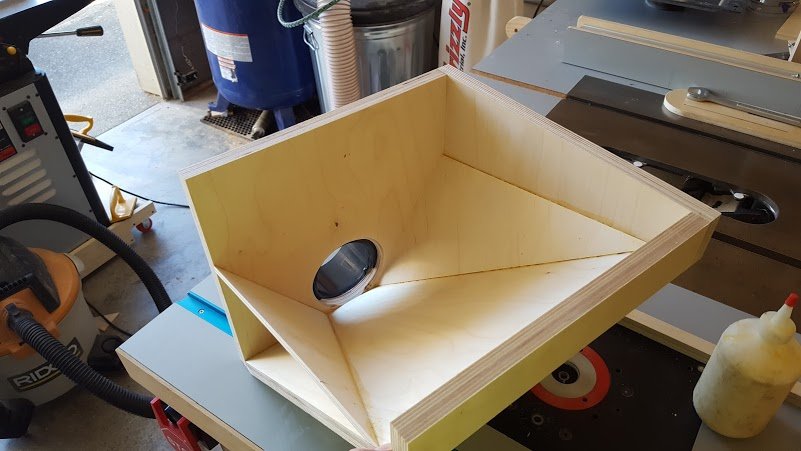
Photo credit: LumberJocks.com
Disadvantages
- You'll still have a lot of smaller dust particles flowing around if nothing is directing the airflow.
- Without a dust port, it's still possible that the sawdust will end up on the floor.
- If you use your saw on a daily basis, you'll need to empty out the box often.
Best For
If woodworking is your hobby and you only use your table saw on weekends, this is the perfect solution for you. Even if you do a few small jobs during the week, it'll still work for you. You can simply empty the box out every time it's full.
I wouldn't recommend a box under the table saw for professional carpenters. You'll still have a lot of sawdust in the air every time you use the saw. You may spend more time emptying the box than working on your craft.
Close the Back of the Saw
Since the motor of a portable table saw is situated outside of the frame, the back of the cabinet is usually open. This opening is another place where sawdust can escape and will reduce the suction power of the dust collector. The best way to rectify this is to close the back of your saw.

Photo credit: DanPattison.com
To accommodate the motor mount and the drive belt, you'll need two plywood panels that fit together. You'll find plans online for similar panels or simply draw your own plan. Instead of drilling holes into your cabinet, imbed magnets into the plywood panels that will hold onto the metal plate.
Advantages
- Catch all the sawdust that will fly out at the back of your saw.
- Improve the suction power and efficiency of the dust collector.
- Improve air quality in your woodshop by allowing fewer dust particles to escape.
Disadvantages
- As you move the blade up and down, the motor and drive belt also moves up and down. You need to ensure that you leave enough open space for these movements.
- Some sawdust may still escape at the openings for the motor bracket and the drive belt.
- This solution won't stop the dust that flies through other gaps on the cabinet.
Best For
Closing the back on any portable or contractor-style table saw will be hugely beneficial. You're able to prevent most of the dust from escaping through this opening and reduce the amount of sawdust in the air.
This is best for you if you've connected a dust collector to the dust port on your saw. You'll improve the efficiency of the dust collector, and you'll be pleased that the investment is worthwhile.
Seal the Gaps
Do yourself a favor and investigate your table saw for small gaps; you'll find plenty. Most of these small gaps will allow sawdust to escape. Upholstery foam is the ideal material to fill in these openings, and it's easy to cut custom pieces. Be careful, though; you don't want to make your saw airtight when you have a dust collector.
Your dust collector needs airflow to work efficiently, but you want to concentrate the suction to the area around the blade. Close all gaps between the tabletop and the cabinet, as well as the openings between the panels on the cabinet. When the air is drawn from openings close to the blade, the sawdust collection will be most efficient.
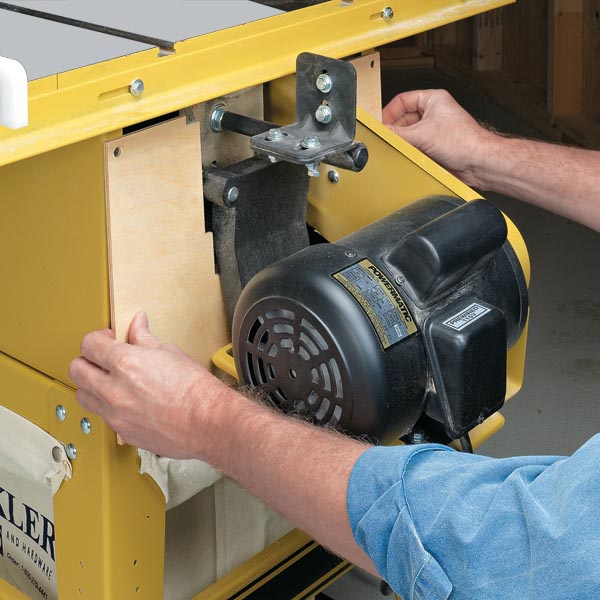
Photo credit: Woodsmith.com
Advantages
- Catching all the dust that normally escapes from small gaps.
- Improving the airflow to the dust collector and its efficiency.
- Achieving a healthier work environment with better air quality.
Disadvantages
- Although it’ll stop sawdust from escaping, it won't be as efficient if there isn't a dust collector connected to a dust port on the saw.
- There'll still be sawdust that flies off the blade on top of the table.
- The foam needs to be replaced from time to time.
Best For
If you've installed a dust collector and you're not happy with its performance, this is one of the first steps to improve that. Filling in the gaps and closing the back will go a long way in directing the airflow. Sealing all the gaps will also reduce the amount of sawdust if you don't have a dust collector.
This is a solution that works both ways. However, if you don't have a dust collector remember to replace or clean these gap fillers. More dust will collect in the foam, and it may defeat the purpose.
Attach a Shop Vac
Attaching a shop vac to your table saw is a quick and easy way to collect the dust from your table saw. If you don't own a shop vac, you may consider investing in one. It works for woodshop cleaning, and you can attach it to power tools with dust ports, as well as your table saw.
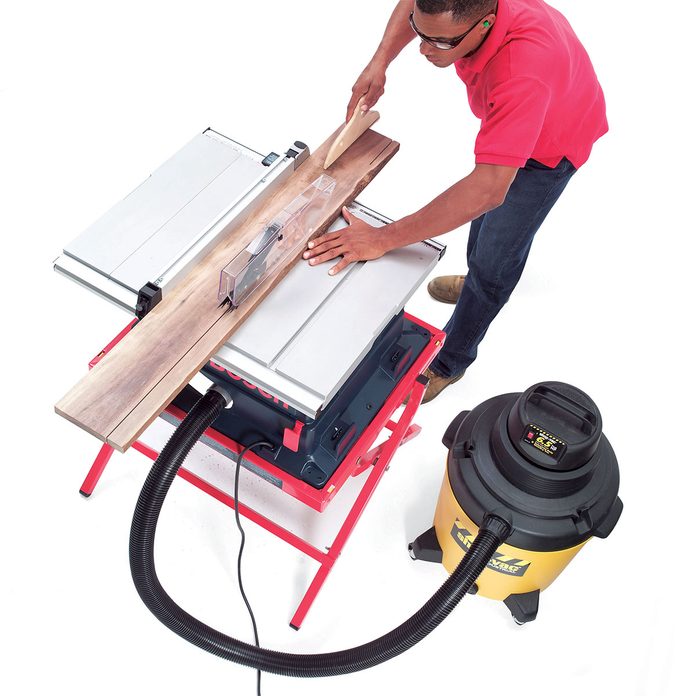
Photo credit: FamilyHandyMan.com
Think of a shop vac as an extremely powerful version of your household vacuum. While the vacuum sucks up regular household dust, a shop vac can handle larger pieces in the woodshop. You may need different attachments for your table saw, but you'll find easy solutions at your DIY store.
Advantages
- Strong suction power that will easily collect dust on your table saw.
- It's a portable unit that can be moved around if needed.
- An excellent tool that you can use around the woodshop and not only for your table saw.
Disadvantages
- You can only attach it to either the overarm collector or the bottom dust port. It won't be as efficient if it's attached to both.
- Since it's a portable unit, you'll have to empty it more often than a built-in unit.
- The filters can only handle a certain amount of dust, so you need to clean it often.
Best For
A shop vac works best with an overarm dust collector. Most of the dust goes down, and the bin on your shop vac may be too small to handle that. At the same time, the suction power on the shop vac will catch the bigger pieces that fly off the top of the blade.
This will prevent these pieces from hitting you in the face. If you have nothing else to connect to the bottom dust port, you can use your shop vac. However, if you do this, ensure that you empty it regularly and that you keep the filters clean.
Buy or Build an Overarm Dust Collector
Gathering dust that flies off the back of the saw blade is the most difficult dust collection feat. Wear overalls when dealing with this dust because you're directly in its fly zone, or what can feel like a shooting range. You can find different ready-made overarm dust collectors available on the market.
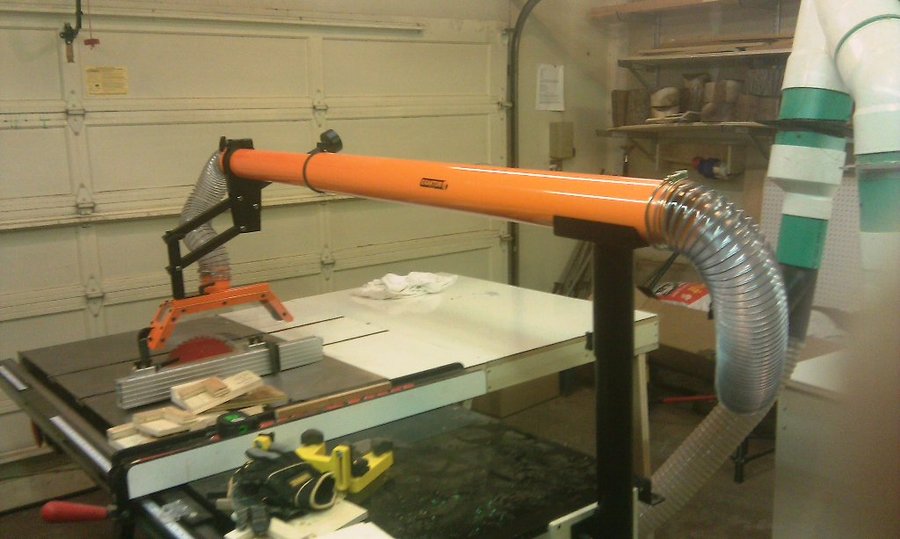
Photo credit: LumberJocks.com
Shop around to find what'll work best for your table saw and woodshop. Another alternative is to custom design and builds your own collector. There are excellent videos and instruction tutorials online to build an overarm collector for your table saw.
Advantages
- Collects all the dust that flies off the top of the blade.
- When installed correctly, it’ll be placed right behind the blade, and only very little sawdust may escape.
- The overarm installation keeps your dust collector out of the way.
Disadvantages
- Building an overarm collector from scratch can be difficult and time-consuming.
- You need to have precise measurements. Incorrect measurements could end in a woodshop disaster. As the saying goes, measure twice, cut once.
- It won't collect all the dust, and some of it may still end up on your clothes and face.
Best For
The overarm dust collector works well with any table saw. Whether you have a cabinet-style, contractor, or portable table saw, you'll find this dust collector extremely helpful, especially if you use your own design.
You'll be able to decide where's the best place to attach it and how to reinforce the table. There are different types of piping and fittings available on the market. With a little online help and exact measurements, this could be a satisfying DIY project.
Buy a Premade Dust Collection System
A premade dust collection system collects all sawdust and debris in a stream of air. The air flows through ductwork to the system's collection area. A large induction motor is used to power the specialized fan for this application.
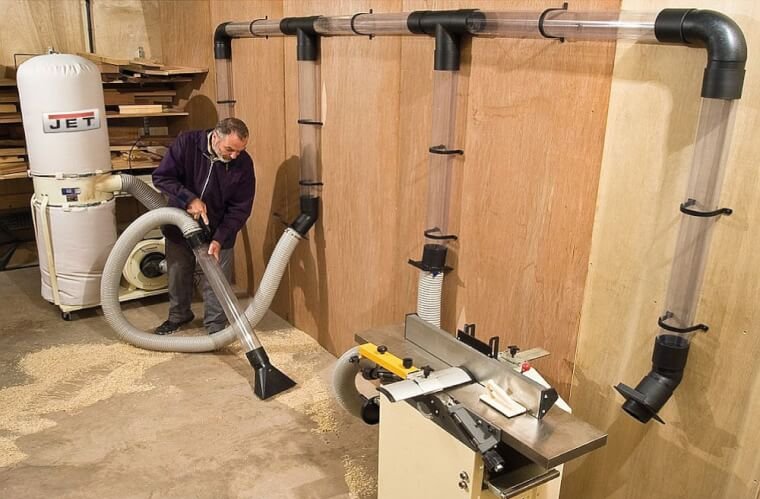
Photo credit: ToolsFirst.com
This fan is called an impeller. As we all know, woodwork equipment produces a substantial amount of dust and debris. The induction motor and impeller work together to generate the volume of airflow that's needed. This is a central system that can be placed out of the way and free up valuable shop space.
Advantages
- It can be moved out of the way and enable you to have more moving space in your woodshop.
- The central dust collection system is permanently connected to your stationary tools. There's no need to disconnect and connect it when you want to use a different tool.
- If you choose the right size dust collection system for your shop, it’ll easily handle dust and chip removal from your stationary equipment.
Disadvantages
- You need to understand static pressure loss to install a system that's powerful enough to move the debris and dust.
- It's not suitable for handheld tools.
- You'll need to take special care planning the ducting network.
Best For
Premade dust collection systems are best for persons that work a lot with stationary equipment. If you're a hobbyist, this may not be a worthwhile investment. Since this equipment is quieter than a shop vac, it's the ideal solution if you spend much time in your woodshop. It can hold more chips, has a larger hose than a shop vac, and can be connected to multiple tools.
Direct the Air, Don't Restrict It
You must direct the air without restricting the airflow. Cover caps on the machine and openings around joints where dust may escape, but don't cover all the openings. You want to allow the air to follow the route that you direct.

Photo credit: DanPattison.com
This route will start at the blade, go through the dust port, and end in the dust collector. Covering all gaps close to the blade and on top of the table will limit the flow. Limiting the flow won't allow dust to reach the collector, and you may need to sweep it up from the floor.
Advantages
- Allow the air to flow naturally.
- Let the dust collector perform optimally.
- Keep your shop floor clean and improve air quality.
Disadvantages
- You'll need to check the gap fillings regularly.
- Some sawdust may still escape.
- You'll need to clean or replace the cap fillings from time to time.
Best For
Directing the airflow through your table saw isn't only best for everyone but important for both hobbyists and professionals. If the airflow is restricted, you'll run into problems around every corner.
The saw may get damaged, and your dust collector won't work efficiently. You may find that you'll spend more time cleaning than woodworking. That's not ideal and definitely not why you started doing this in the first place.
Table Saw Dust Collection Solutions
Any of the solutions mentioned will make your cleaning task easier. Whether you decide to only fill in the gaps or connect a shop vac, you'll have less sawdust to deal with than before.
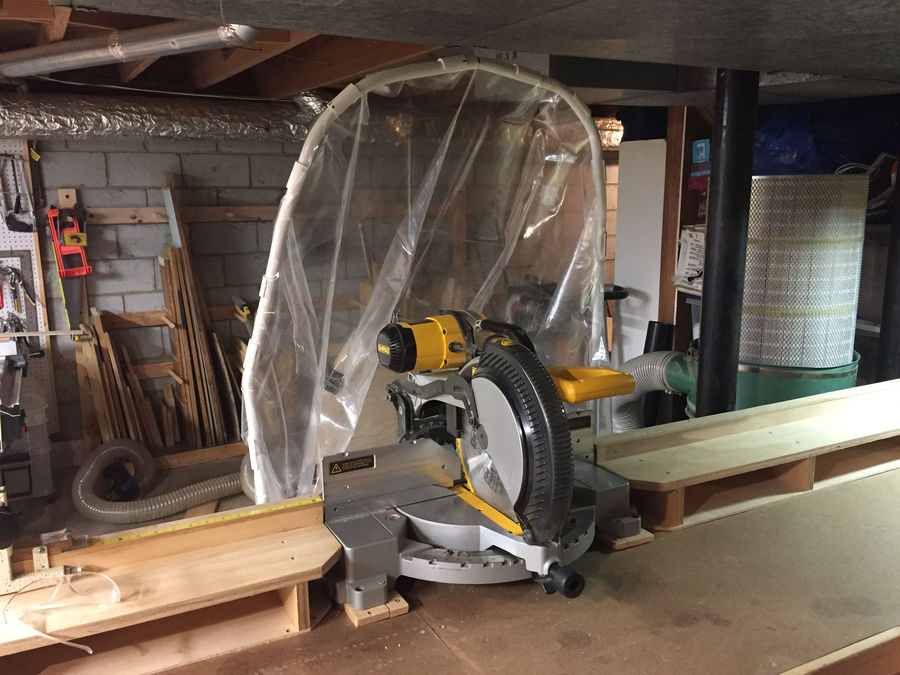
Photo credit: SimpleCove.com
Remember, you won't have to do this all at once. If you only start with a box to collect the dust, you can add solutions as you please. Any combination of these methods will help improve your woodworking experience.
Table Saw Collection Tips and Tricks
No One Solution Fits Everyone
Not every woodshop is the same, and not every woodworker has the same requirements. There's a variety of methods to reduce the amount of sawdust from your table saw.
Get the relevant info, decide what will work for you, and implement it. Mix and match, experiment, and find the combination that you'll be happy with.
Add a Cyclone Dust Separator
To save your filters or use fewer of them, add a cyclone dust separator. The cyclonic action separates the sawdust before it reaches the dust collector. This keeps the collector's filters clean and helps to have maximum suction power at all times.
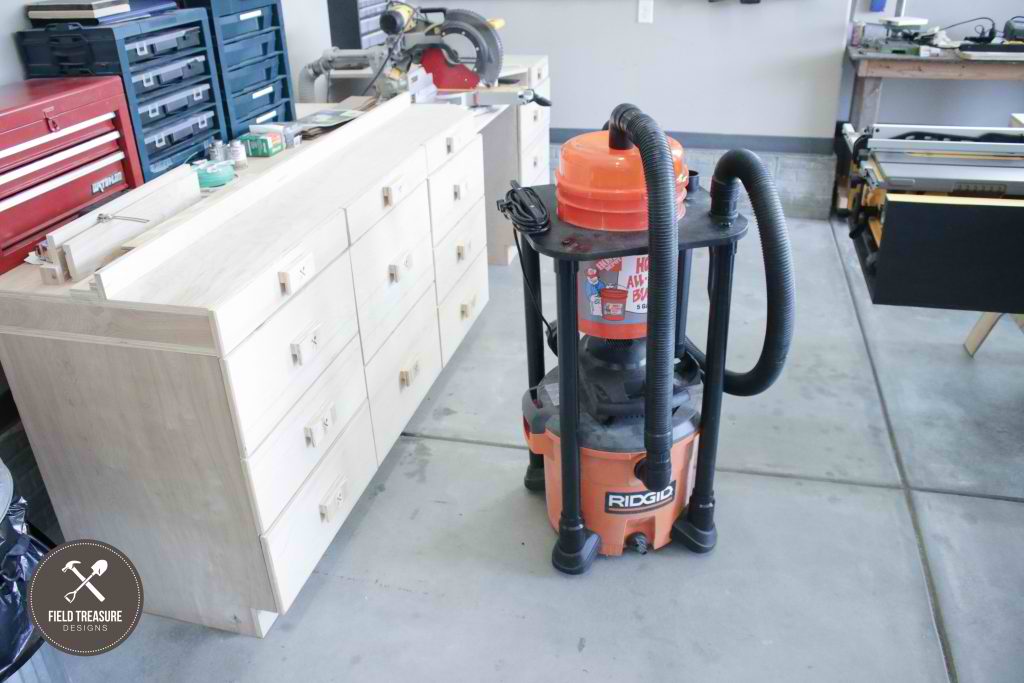
Photo credit: FieldTreasureDesigns.com
If you're using a plastic bag inside the collector's drum for easy disposal, this bag will be sucked up into the cyclone separator. You'll need to place something inside to keep the bag in place. A simple solution is to make a round frame out of plastic-coated wire and place it in the bag. Be sure to remove this before you dispose of the bag.
Place Stationery Tools Close to the Central Dust Collector
To make the installation and ducts for your central dust collector easier, place stationary machinery closer to the collector. This will include your table saw and thickness planer.
If your machines are portable, this won't be necessary. Simply move them closer when you use them. If you want to make this a permanent installation, plan carefully to get the maximum use of your dust collector.
Install An Air Cleaner
An air cleaner will collect airborne sawdust that isn't captured by the other dust collectors. If it's hanging close to one wall, it’ll create a circular movement of air that will improve the filtration efficiency. The ideal is to have a two-stage filter system that draws in the dusty air and lets clean air out on the other end.
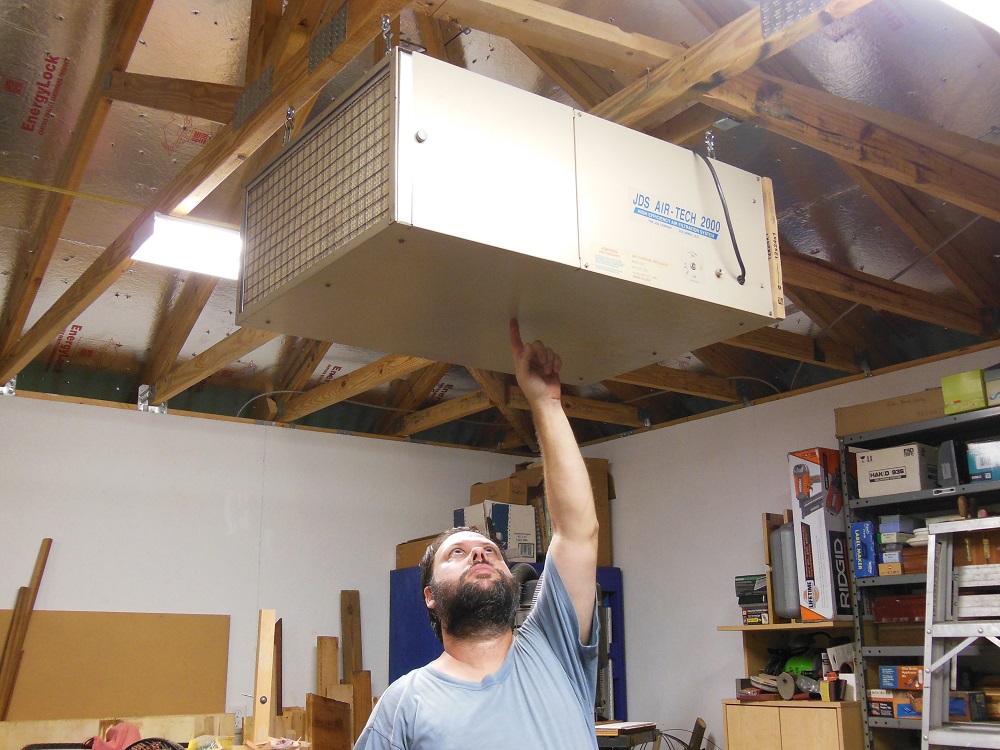
Photo credit: HomeFixated.com
Most air cleaners have a timer that allows you to let it run after you've left your shop. This will gather any sawdust that's left in the air and prevent dust from settling on the surfaces. At the same time, you'll be able to enjoy dust-free air when you walk into your woodshop.
Conclusion
Keep your woodshop as dust-free as possible to enjoy woodworking for a long time. It's good for your health, and you'll spend less to clean up. With these many options, it shouldn't be too difficult to find a solution that works for you.
People Also Ask
There's always something that could be added, and you may have questions that weren’t answered. Here are answers to questions that people also ask.
Is Table Saw Dust Dangerous?
Yes, table saw dust can cause a variety of dangerous health issues. These may include skin and eye irritation, reduced lung function, asthma, allergy, and nasal cancer.
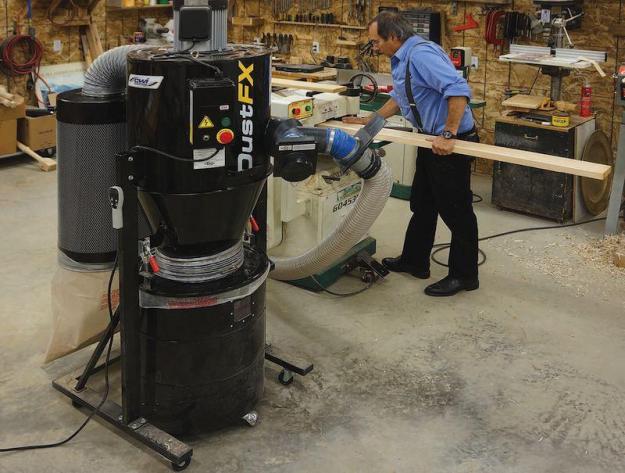
Photo credit: CanandianWoodworking.com
What Do I Do With the Dust I Collect?
You can add sawdust to your compost heap or use it as a natural weed killer. You can also donate it to a company that'll recycle it.
How Often Should I Empty My Dust Collector?
Be sure to never let your dust collector become overfilled. Check it regularly and empty it when needed.
